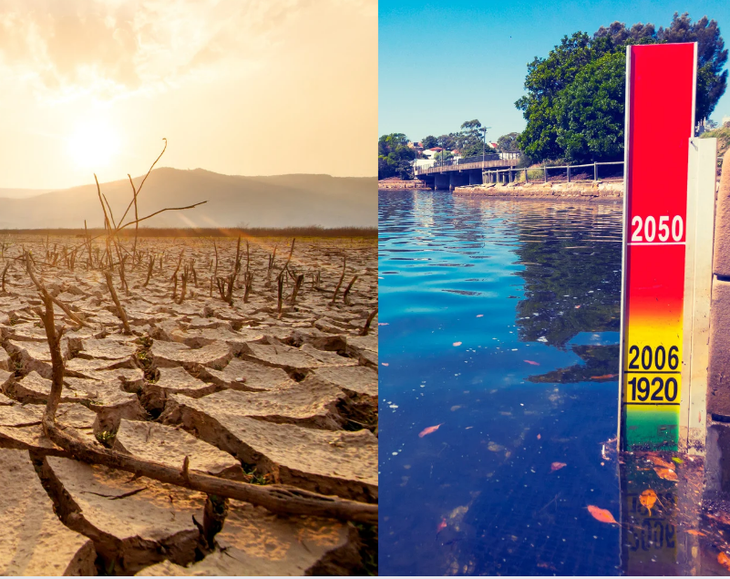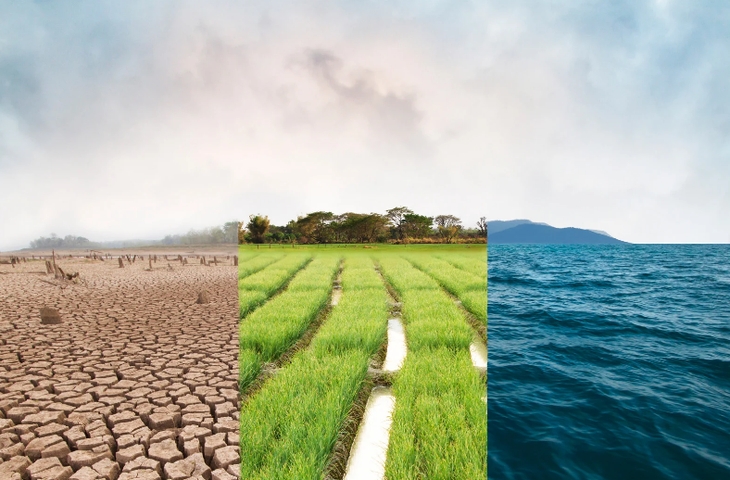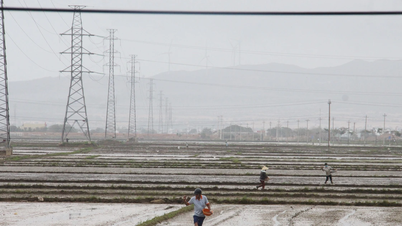
Drought and sea level rise, two seemingly contradictory phenomena, are actually complexly linked - Photo: AI
Excessive groundwater extraction, prolonged droughts, and faster evaporation due to rising temperatures are severely depleting the Earth's freshwater resources. A new study indicates that the phenomenon of "drying continents" is contributing to sea level rise faster than even the melting of polar ice.
The more severe the drought, the higher the sea level.
According to research published in the journal Science Advances , over the past two decades, surface freshwater resources such as lakes, aquifers, and soil moisture have been severely depleted. The main causes are climate change, rising temperatures leading to faster evaporation, prolonged droughts, and excessive groundwater extraction.
Professor Jay Famiglietti from Arizona State University, a member of the research team, said: "We use a lot of water for farming. If this situation doesn't change, food security and access to clean water will be seriously threatened."
According to the authors, these changes "send one of the most serious messages about the impact of climate change ever." Continents are drying up, freshwater resources are dwindling, and sea levels are rising.
The study is based on data from four NASA satellites, tracking the movement of water on Earth over the past 22 years, including melting ice, groundwater, and surface water. This provides scientists with a comprehensive view of the disrupted global water cycle.
Since 2014, already arid regions have become even drier. Some drought-prone areas have coalesced into "super-drought zones" stretching from Central America, Mexico, California, and the southwestern United States to the Colorado River basin and the High Plains in the south.
"The key message here is: water is the biggest driver of change both on land and in the ocean," said scientist Benjamin Hamlington from NASA's Jet Propulsion Laboratory (JPL).

Agriculture will suffer serious consequences from abnormal climate change - Photo: AI
How do droughts and rising sea levels affect each other?
With the exception of Greenland and Antarctica, all major continents around the world are experiencing drought conditions not seen since 2002.
According to research, three-quarters of the global population lives in countries with rapidly dwindling freshwater resources. Meanwhile, rising sea levels threaten to encroach further into coastal areas, reducing habitability and accelerating the risk of severe flooding and storms. In the US, extreme weather events are causing the insurance industry to withdraw from many coastal cities due to the overwhelming risks.
Droughts and rising sea levels may seem like two opposing climate phenomena: one is drought and water scarcity, the other is rising water causing flooding. However, scientists have shown that they can actually influence each other, especially in the context of current climate change.
In coastal regions like California, research shows that during droughts, sea levels can rise higher than normal. This is because less freshwater flows from the land into the sea, allowing more saltwater from the ocean to penetrate further inland. At the same time, increased evaporation in hot, dry conditions also contributes to a slight rise in sea level due to changes in atmospheric pressure and hydrological cycles.
Conversely, as sea levels rise, saltwater can infiltrate groundwater and rivers in coastal areas, causing salinization of freshwater sources. This makes it difficult for agricultural land to retain moisture and for crops to absorb water, exacerbating drought conditions, especially in areas that rely on freshwater from rivers and groundwater.
In other words, droughts can cause saltwater intrusion to occur further inland, while rising sea levels can exacerbate water scarcity. This vicious cycle is leaving coastal areas facing a double climate risk, from prolonged droughts to saltwater intrusion and water insecurity.
From a scientific perspective, drought and sea level rise are two manifestations of changes in the global energy balance and water cycle. As the climate warms, evaporation from land and oceans increases, causing a shortage of moisture on land (drought) while simultaneously melting ice at the poles and causing thermal expansion of seawater, leading to rising sea levels.
Droughts reduce the amount of freshwater flowing from rivers to the sea, altering salinity and sea surface temperature—two crucial factors controlling ocean currents. This change can, in turn, affect seasonal rainfall, creating an unstable climate feedback loop.
Furthermore, saltwater intrusion caused by rising sea levels disrupts the structure of groundwater aquifers, which are the primary water source during the dry season. Once these aquifers become saline, their recovery is very slow, making subsequent droughts even more severe.
Scientists believe that the link between sea level rise and land-based water loss is a sign that the natural water cycle is being severely disrupted.
When water is drawn away from the continent, the only place it can go is the ocean. Approximately 88% of the water vapor in the atmosphere eventually falls and flows into the sea.
Closely monitoring onshore water storage is extremely important. If we know where the water is going, we can improve our predictions of future droughts, floods, and water supply.
Source: https://tuoitre.vn/nghich-ly-khi-hau-dat-cang-kho-han-bien-dang-cang-nhanh-2025072710044955.htm


![[Photo] Prime Minister Pham Minh Chinh attends the Conference on the Implementation of Tasks for 2026 of the Industry and Trade Sector](/_next/image?url=https%3A%2F%2Fvphoto.vietnam.vn%2Fthumb%2F1200x675%2Fvietnam%2Fresource%2FIMAGE%2F2025%2F12%2F19%2F1766159500458_ndo_br_shared31-jpg.webp&w=3840&q=75)














































































































Comment (0)